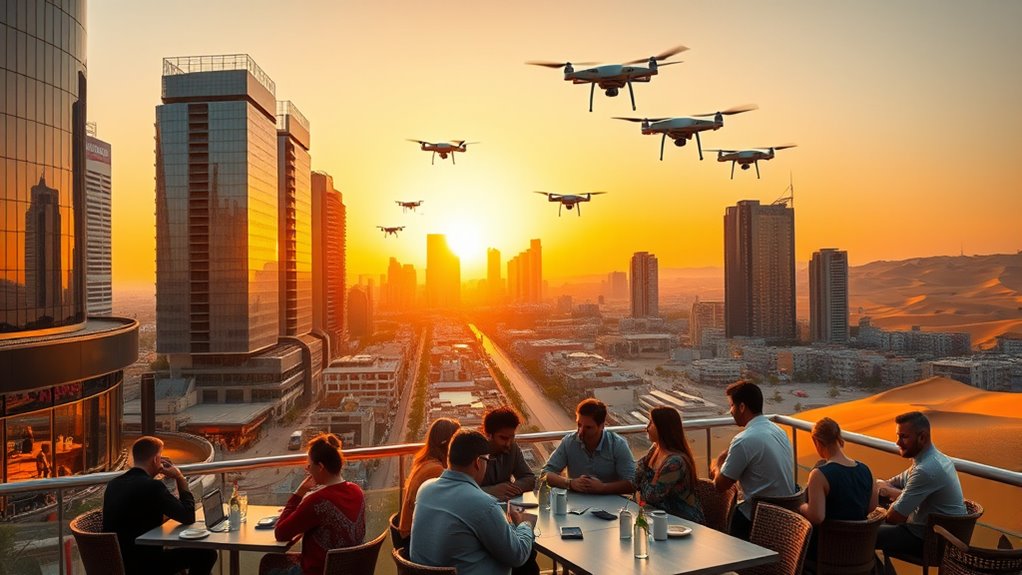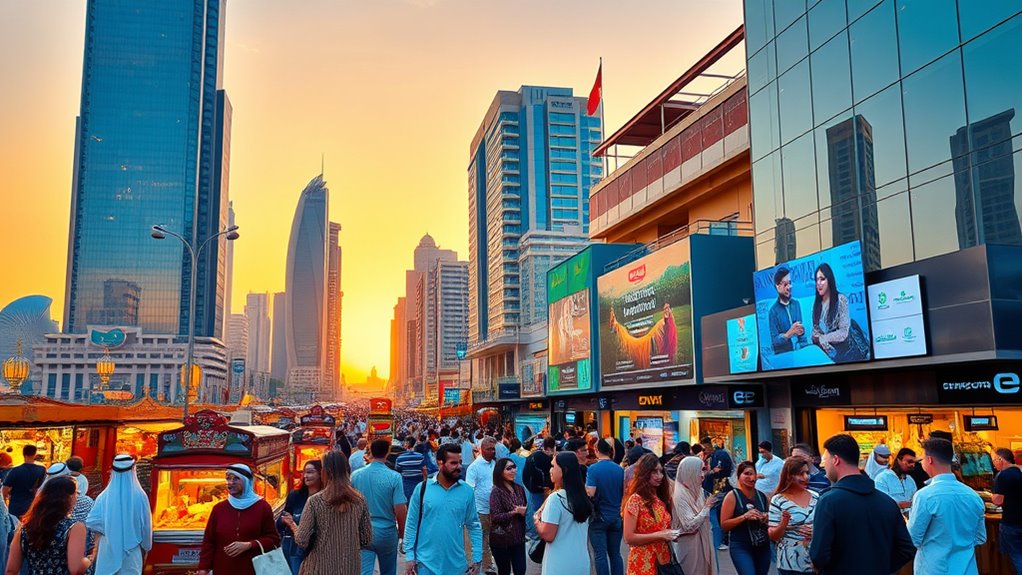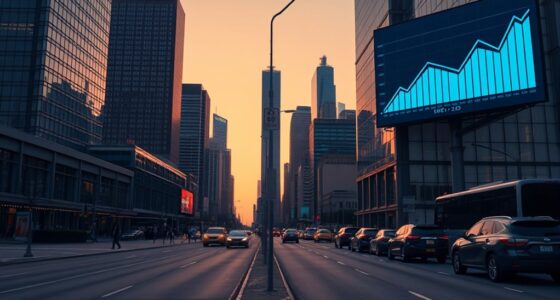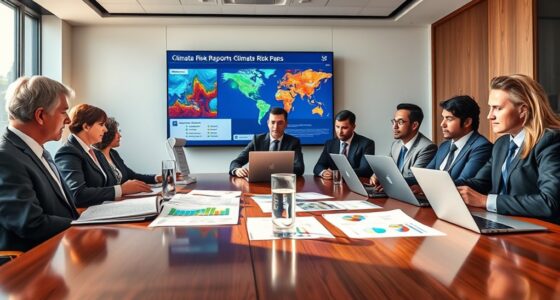The Middle East is actively diversifying its economy by investing in tourism, technology, and talent to reduce dependence on oil. Countries are restoring historic sites, promoting cultural festivals, and boosting infrastructure for travelers. At the same time, they’re funding innovation hubs, startups, and green energy projects to create new industries and jobs. These efforts aim to build a resilient, sustainable, and culturally rich region. Keep exploring to discover how these initiatives shape the future of the Middle East.
Key Takeaways
- Middle Eastern countries are investing heavily in tourism, blending modern attractions with cultural heritage sites to diversify economies.
- Significant funding is allocated to technology hubs and startups to foster innovation and attract international talent.
- Sustainable energy projects, such as solar and wind, support economic resilience and position the region as a leader in green technology.
- Preservation of cultural traditions and heritage sites boosts tourism and fosters regional pride.
- Diversification strategies aim to reduce oil dependency, ensuring long-term economic stability and growth.

Have you ever wondered how the Middle East is shifting its economic focus beyond oil? It’s a region that’s increasingly embracing diversification, not just by developing its tourism and tech sectors but also by investing in sustainable energy and preserving cultural heritage. This shift reflects a strategic move to create a more resilient economy while respecting the history and environment that define the region.
The Middle East is diversifying its economy through sustainable energy, tourism, and cultural preservation for a resilient future.
You’ll notice that countries like the United Arab Emirates and Saudi Arabia are making significant strides in sustainable energy. They understand that reducing dependence on fossil fuels isn’t just an environmental priority; it’s essential for long-term economic stability. Solar and wind projects are sprouting across deserts, harnessing natural resources to generate clean power. Not only does this approach help cut carbon emissions, but it also positions these nations as leaders in green technology. By investing in sustainable energy, they’re laying the groundwork for future industries, creating jobs, and attracting foreign investment.
At the same time, cultural heritage remains a cornerstone of regional identity and a key component of economic diversification. The Middle East is rich with ancient sites, museums, and traditions that draw millions of tourists each year. Countries are actively working to preserve their cultural assets while making them accessible to visitors. This includes restoring historic landmarks, promoting local crafts, and hosting festivals that celebrate their unique histories. These efforts boost tourism revenue and foster a sense of pride among residents. You’ll see that cities like Dubai and Doha are blending modernity with tradition, creating vibrant spaces where history coexists with innovation. This balance is essential, as it guarantees that development respects local identities and promotes sustainable tourism practices.
The region’s focus on technology plays an integral role in this transformation. Governments are investing heavily in innovation hubs, startups, and digital infrastructure. This creates opportunities for entrepreneurs and skilled professionals, helping to diversify economies that once relied solely on oil exports. Talent from within the region and beyond is being cultivated and attracted to these burgeoning sectors, further fueling growth. The emphasis on tech, combined with sustainable energy initiatives and the preservation of cultural heritage, demonstrates a complete strategy to build a resilient, diversified economy.
Ultimately, the Middle East’s shift toward sustainable energy and cultural preservation isn’t just about economic growth—it’s about creating a future that’s environmentally responsible and culturally rich. By embracing these elements, the region is transforming itself into a dynamic hub of tourism, innovation, and talent, ensuring its relevance for generations to come.
Frequently Asked Questions
How Is Political Stability Impacting Diversification Efforts in the Middle East?
Political stability plays a vital role in your diversification efforts in the Middle East. When stability is strong, it encourages investment and supports economic reform, making it easier for you to develop sectors like tourism, tech, and talent. Conversely, instability can hinder progress, scare off investors, and delay reforms. By maintaining political stability, you create a safer environment that fosters growth, attracts international partnerships, and accelerates your diversification goals.
What Role Do Foreign Investments Play in Regional Diversification Strategies?
Foreign investments play a vital role in regional diversification strategies by fueling economic growth and creating new opportunities. When you attract foreign investment, you bring in capital that helps develop sectors like tourism, tech, and talent. This not only boosts innovation but also reduces reliance on traditional resources, making the economy more resilient. Your region can accelerate diversification efforts and strengthen its global position through strategic foreign investment.
Which Middle Eastern Countries Are Leading in Tourism Development?
You’ll find the United Arab Emirates, especially Dubai and Abu Dhabi, leading in tourism development. They invest heavily in luxury resorts and promote their rich cultural heritage to attract international visitors. Qatar and Oman also excel by blending modern luxury with historic sites. These countries focus on creating unique experiences, drawing tourists seeking both opulence and cultural authenticity, bolstering their economies through diversified tourism sectors.
How Are Local Communities Benefiting From Diversification Initiatives?
You’ll be pleased to know that local communities benefit greatly from diversification initiatives—over 60% report improved living standards. Through community engagement, locals participate actively in tourism, tech, and cultural projects, creating jobs and fostering pride. These efforts promote cultural preservation, ensuring traditions thrive amid modernization. As a result, communities feel more empowered, connected, and resilient, making diversification a win-win for everyone involved.
What Challenges Do Startups Face in the Middle East’s Tech Sector?
You’ll face challenges like securing startup funding, which is often limited or slow to come by. Talent acquisition can also be tough, as skilled professionals are in high demand and sometimes hard to attract due to competition or regional constraints. Managing bureaucratic hurdles and establishing a strong network are critical, but these obstacles can slow down your growth and innovation in the Middle East’s dynamic tech landscape.
Conclusion
As you explore the Middle East’s push for diversification, it’s clear that tourism, tech, and talent play vital roles. While some believe these efforts will rapidly transform the region’s economy, others argue true change requires addressing deeper structural issues. By investing in innovation and human capital, the Middle East might just challenge longstanding perceptions and create sustainable growth. Ultimately, embracing both tradition and modernization could be the key to a resilient, diversified future.








